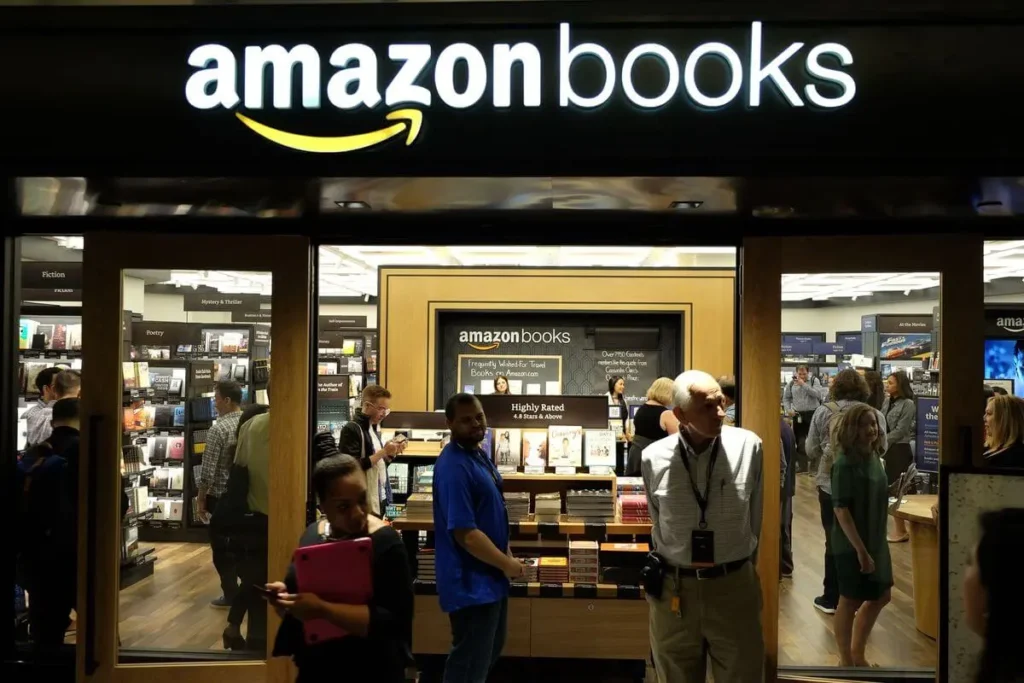In the ever-evolving landscape of global commerce, few companies have left as indelible a mark as Amazon. From its modest beginnings as an online bookstore in 1994, Amazon has grown into a behemoth influencing virtually every sector of the economy, including retail, cloud computing, entertainment, and logistics. This transformation was not accidental but the result of a meticulously crafted strategy centered around customer obsession, technological innovation, and diversification.
Market Capitalization
Annual Revenue in 2022
Employees
Prime Members
AWS Revenue
Table of Contents
The Birth of Amazon
Jeff Bezos and the Vision
Jeff Bezos, born on January 12, 1964, in Albuquerque, New Mexico, exhibited an early aptitude for technology and entrepreneurship. Raised by his mother, Jacklyn, and his stepfather, Miguel Bezos, Jeff showed an early interest in how things worked, often dismantling gadgets to understand their mechanics.
After graduating from Princeton University in 1986 with degrees in electrical engineering and computer science, Bezos embarked on a career on Wall Street. He worked at several firms, including Fitel, Bankers Trust, and D. E. Shaw & Co., where he became the youngest senior vice president. However, the burgeoning possibilities of the internet captured his imagination.
In 1994, recognizing the untapped potential of the internet, which was growing at a staggering 2,300% annually, Bezos decided to leave his lucrative job. He famously drafted the business plan for his online venture during a cross-country drive from New York to Seattle, laying the groundwork for what would become Amazon. His parents invested a significant portion of their life savings into the venture, demonstrating their belief in his vision.
Launching an Online Bookstore
Books were chosen as the initial product category due to their universal appeal and the vast number of titles available in print—over 3 million at the time. On July 16, 1995, Amazon.com went live, offering books to customers across the United States and 45 other countries. The company operated out of Bezos’s garage in Bellevue, Washington, with a handful of employees.
The early days were challenging. The team had to innovate solutions for online transactions, inventory management, and customer service in an uncharted digital landscape. Yet, within the first month, Amazon had sold books to customers in all 50 states and 45 countries.
This rapid growth validated Bezos’s belief in the internet’s potential to revolutionize retail. Bezos’s vision extended beyond books; he aimed to create a store that offered “everything” customers might want. This ambition was encapsulated in the company’s mission to become “Earth’s most customer-centric company.”

Customer-Centric Philosophy
The Obsession with Customer Experience
Amazon’s mission statement—”to be Earth’s most customer-centric company”—is more than just words. This philosophy drives every decision, from product development to business expansion. Bezos believes that by focusing on customers, Amazon can continually improve and innovate.
“We see our customers as invited guests to a party, and we are the hosts.” — Jeff Bezos
This customer-first approach manifests in several ways:
- Listening to Feedback: Amazon actively encourages customer reviews and feedback to improve products and services.
- Long-Term Thinking: Decisions are made with a long-term perspective on customer satisfaction, even if it means short-term sacrifices.
- Innovating on Behalf of the Customer: Amazon continually seeks to anticipate customer needs and desires, often before customers are aware of them themselves.
Innovations in Customer Service
Amazon introduced several pioneering features to enhance customer experience:
- Customer Reviews: Allowing users to post reviews, both positive and negative, fostering a community and aiding informed purchasing decisions. This transparency built trust and differentiated Amazon from competitors.
- Personalized Recommendations: Using algorithms to suggest products based on browsing and purchasing history, making shopping more convenient and engaging.
- One-Click Ordering: Streamlining the purchase process to reduce friction, patented in 1999, which significantly increased conversion rates.
- Amazon Prime: Launched in 2005, offering unlimited free two-day shipping for an annual fee, which increased customer loyalty and purchase frequency. Over time, Prime expanded to include streaming services, exclusive deals, and more, creating a comprehensive membership program.
Technological Innovations
Personalization and Recommendations
Amazon’s use of artificial intelligence and machine learning has been instrumental in its success. The company developed sophisticated algorithms to analyze customer behavior, enabling:
- Product Recommendations: Suggesting items based on previous purchases and browsing history, which accounted for a significant portion of sales.
- Dynamic Content: Personalizing the homepage and emails to reflect individual customer interests.
- Collaborative Filtering: Grouping customers with similar preferences to enhance recommendation accuracy.
These technologies not only enhance the shopping experience but also increase sales and customer retention. By making the platform more intuitive and personalized, Amazon keeps customers engaged and satisfied.
Leveraging Big Data
Data is at the heart of Amazon’s operations. The company collects vast amounts of data on customer preferences, market trends, and operational metrics. This data-driven approach informs decisions on:
- Inventory Management: Optimizing stock levels to meet demand without overstocking, reducing holding costs, and avoiding stockouts.
- Supply Chain Optimization: Improving efficiency from warehouse operations to last-mile delivery, reducing costs and delivery times.
- Product Development: Identifying gaps in the market and developing Amazon-branded products, such as AmazonBasics.
Amazon’s ability to harness big data has given it a competitive edge, allowing for real-time adjustments and strategic planning based on empirical evidence.
Diversification and Expansion
From Books to Everything
Following the initial success with books, Amazon expanded into other product categories:
- 1998: Music and video, capitalizing on the popularity of CDs and VHS tapes.
- 1999: Consumer electronics, toys, and games, responding to customer demand and market opportunities.
- Early 2000s: Apparel, home goods, jewelry, and more, steadily moving toward the vision of the “everything store.”
This diversification was strategic, leveraging Amazon’s growing customer base and infrastructure to enter new markets. It allowed Amazon to increase its market share and become a one-stop-shop for consumers.
Amazon Marketplace
In 2000, Amazon launched the Marketplace platform, allowing third-party sellers to offer products alongside Amazon’s own inventory. This move significantly expanded the product selection and introduced competitive pricing.
- Benefits:
- Increased Selection: More products attract more customers, enhancing the shopping experience.
- Competitive Prices: Sellers compete, often lowering prices, benefiting consumers.
- Revenue Streams: Amazon earns through commissions and fees, diversifying its income.
Marketplace sellers now account for more than half of the units sold on Amazon, demonstrating the success of this platform in scaling Amazon’s retail operations.
Supply Chain and Logistics Mastery
Fulfillment Centers
Amazon revolutionized logistics with its network of fulfillment centers strategically located worldwide. These centers employ advanced technologies like robotics and automation to expedite order processing.
- Key Innovations:
- Kiva Robots: Acquired in 2012 for $775 million, these robots automate the movement of goods within warehouses, increasing efficiency and reducing labor costs.
- Smart Shelving: Products are stored based on data analytics predicting demand, optimizing retrieval times.
- Cross-Docking: Minimizing storage time by directly transferring incoming shipments to outgoing orders.
By streamlining warehouse operations, Amazon has reduced order processing times and operational costs, passing these efficiencies on to customers through faster delivery and lower prices.
Last-Mile Delivery Innovations
Ensuring timely delivery has been a cornerstone of Amazon’s customer satisfaction strategy.
- Amazon Logistics: Developing its own delivery fleet, including vans, cargo planes (Amazon Air), and partnerships with local couriers, reducing reliance on traditional carriers like UPS and FedEx.
- Drone Delivery: Initiating Amazon Prime Air to deliver packages via drones, aiming to deliver items in 30 minutes or less.
- Amazon Flex: A gig-economy program where independent contractors deliver packages using their vehicles, expanding delivery capacity.
- Amazon Key: A service allowing delivery personnel to place packages inside homes or cars, addressing security concerns with unattended deliveries.
These innovations address the “last-mile” challenge in logistics, improving delivery speed and reliability, and enhancing customer satisfaction.
Amazon Web Services (AWS)
The Birth of AWS
In 2006, Amazon launched Amazon Web Services, offering cloud computing services to businesses and governments. This move capitalized on Amazon’s existing infrastructure and expertise in handling massive data and web traffic.
- Services Offered:
- Compute Power: Amazon Elastic Compute Cloud (EC2) provides scalable virtual servers.
- Storage Solutions: Amazon Simple Storage Service (S3) offers reliable and scalable storage.
- Database Management: Amazon Relational Database Service (RDS) simplifies database setup and operation.
Dominance in Cloud Computing
AWS has become the leading cloud service provider globally, contributing significantly to Amazon’s profitability.
- Market Share: As of 2021, AWS holds about 32% of the cloud market, ahead of competitors like Microsoft Azure and Google Cloud.
- Clients: Organizations like Netflix, NASA, Airbnb, and the CIA rely on AWS for critical infrastructure.
AWS’s success has diversified Amazon’s revenue streams, making it less dependent on retail operations and highlighting its strength as a technology company.
Entering the Entertainment Industry
Amazon Studios and Prime Video
To bolster its Prime membership value, Amazon ventured into digital streaming and content production.
- Amazon Prime Video: Launched in 2006 as Amazon Unbox, it has evolved into a major streaming platform offering movies, TV shows, and original content.
- Amazon Studios: Established in 2010 to produce original content, competing with Netflix and traditional studios.
Acquisitions and Original Content
- Acquisition of MGM Studios: In 2021, Amazon acquired MGM for $8.45 billion, adding a vast library of content, including franchises like James Bond and Rocky.
- Original Series and Films: Productions like The Marvelous Mrs. Maisel, Transparent, and The Man in the High Castle have won critical acclaim and awards.
- Investment in Sports: Secured rights to stream NFL Thursday Night Football and Premier League matches, attracting sports fans to the platform.
By investing in entertainment, Amazon enhances the value proposition of Prime, encourages customer retention, and enters a lucrative industry.
Physical Retail and Beyond
Acquisition of Whole Foods Market
In 2017, Amazon purchased Whole Foods Market for $13.7 billion, marking a significant move into brick-and-mortar retail.
- Strategic Benefits:
- Physical Presence: Access to over 470 stores in prime locations.
- Supply Chain Integration: Enhanced grocery delivery services through Amazon Fresh, offering same-day delivery.
- Customer Data: Gaining insights into in-store shopping behaviors.
The acquisition allowed Amazon to merge online and offline retail, offering omnichannel experiences and challenging traditional grocery retailers.
Amazon Go and Cashierless Technology
Amazon Go stores utilize “Just Walk Out” technology, allowing customers to shop without checkout lines.
- Technology Used:
- Computer Vision: Cameras track customer movements and item selections.
- Sensors and AI: Detect when products are taken or returned to shelves.
- Automatic Billing: Charges customers’ Amazon accounts upon exit.
This innovation could disrupt traditional retail by eliminating the need for cashiers, reducing labor costs, and enhancing convenience for shoppers.
Global Expansion Strategies
International Markets
Amazon has expanded into numerous countries, adapting to local markets:
- Europe: Launched localized websites in the UK (1998), Germany (1998), France (2000), Italy (2010), Spain (2011), and more.
- Asia: Entered Japan (2000), China (2004), India (2013), and Singapore (2017).
- Latin America: Expanded into Brazil (2012) and Mexico (2013).
Adapting to Local Cultures
Success in global markets requires localization:
- India:
- Payment Solutions: Introduced cash on delivery due to low credit card penetration.
- Amazon Saheli: Launched programs like Amazon Saheli to empower women entrepreneurs.
- Local Partnerships: Collaborated with local sellers and adapted to regulatory requirements.
- China:
- Faced stiff competition from Alibaba and JD.com, leading to the closure of its domestic marketplace in 2019.
- Shifted focus to cross-border selling and AWS services.
- Australia and Middle East:
- Acquired local e-commerce sites like Souq.com to establish a foothold in the Middle East.
Adapting to local regulations, cultural preferences, and market conditions is crucial for Amazon’s international success.
Corporate Culture and Leadership
Leadership Principles
Amazon operates under 16 leadership principles that guide employee behavior and decision-making. Notable principles include:
- Customer Obsession: Prioritizing customer needs above all else.
- Ownership: Taking responsibility for decisions and outcomes, acting on behalf of the entire company.
- Invent and Simplify: Encouraging innovation and finding ways to simplify processes.
- Bias for Action: Valuing speed in decision-making and execution.
- Frugality: Accomplishing more with less, optimizing resource utilization.
Full list of principles
Innovative Work Environment
Amazon fosters a culture where experimentation is encouraged, and failures are seen as learning opportunities.
- “Day 1” Mentality: Bezos emphasizes maintaining the energy and urgency of a startup, avoiding complacency.
- Two-Pizza Teams: Small, autonomous teams that can be fed with two pizzas, promoting agility and faster decision-making.
- Embracing Failure: Projects like the Fire Phone failed commercially but provided valuable lessons that contributed to future successes like Alexa and Echo devices.
This culture drives continuous innovation and adaptability, essential in the fast-paced tech industry.
Challenges and Criticisms
Labor Practices
Amazon has faced scrutiny over working conditions in its fulfillment centers.
- Reports of High Pressure: Employees report strict productivity targets, limited breaks, and strenuous physical demands.
- Unionization Efforts: Workers in some locations, such as Bessemer, Alabama, have attempted to unionize to address grievances.
Amazon has responded by increasing wages, offering benefits, and investing in safety measures. However, debates over labor practices continue.
Antitrust Issues
As Amazon’s market influence grows, so does regulatory attention.
- Antitrust Investigations: Authorities in the U.S. and EU are examining Amazon’s business practices, particularly regarding third-party sellers and potential self-preferencing.
- Market Dominance Concerns: Critics argue that Amazon’s control over data and platform gives it unfair advantages, stifling competition.
- Response: Amazon contends that its innovations benefit consumers and that it operates in competitive markets.
Regulatory outcomes may impact Amazon’s future operations and strategies.
The Future of Amazon
Emerging Technologies
Amazon continues to invest in cutting-edge technologies:
- Artificial Intelligence: Enhancing Alexa’s capabilities, developing AI-driven services, and improving customer experiences.
- Healthcare: Launching Amazon Pharmacy and exploring telehealth services through Amazon Care, aiming to disrupt the healthcare industry.
- Autonomous Vehicles: Acquired self-driving startup Zoox in 2020, indicating interest in autonomous transportation and logistics.
- Space Exploration: Bezos’s Blue Origin could intersect with Amazon’s logistics and satellite internet services (Project Kuiper).
Continued Disruption
With its resources and innovative culture, Amazon is poised to disrupt additional industries.
- Financial Services: Potential entry into banking and finance, offering services like Amazon Cash and lending programs for sellers.
- Education: Providing online learning platforms and certification programs through AWS Educate and other initiatives.
- Sustainability Initiatives: Committed to achieving net-zero carbon emissions by 2040 through The ClimatePledge.
Amazon’s future moves will likely continue to reshape industries and challenge existing paradigms.
Conclusion
Amazon’s rise from an online bookstore to a global conglomerate is a testament to strategic vision, relentless innovation, and a steadfast commitment to customer satisfaction. Jeff Bezos’s leadership has been instrumental in fostering a culture that not only embraces change but also drives it.
The company’s disruptive business model demonstrates how a customer-centric approach and diversification can lead to market dominance. As Amazon continues to expand into new territories and industries, its impact on the global economy and daily life remains profound.
From revolutionizing e-commerce to pioneering cloud computing and exploring the frontiers of AI and space, Amazon embodies the spirit of innovation. Its journey offers valuable lessons on the importance of vision, adaptability, and an unwavering focus on the customer.


